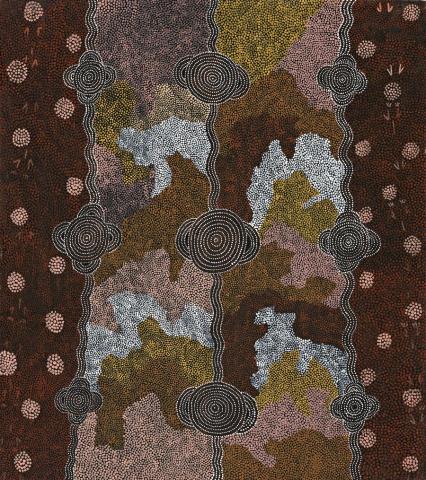WALLABY DREAMING, 1977
TIM LEURA TJAPALTJARRI
synthetic polymer paint on canvas
178.0 x 157.5 cm
inscribed verso: artist's name, date and location
Originally commissioned by Papunya Tula Artists Pty Ltd, Alice Springs.
Prior to delivery the work was inadvertently purchased directly from the artist in 1977 by a Mr Bosic Wonga. Mr Bosic Wonga was researching a book in the region at the time.
Private collection, Melbourne
This painting is accompanied by two letters, one from Mr Bosic Wonga and the other from Mr John Kean, the co-ordinator of Papunya Tula Artists at the time.
Wonga. B., Dingoes Den, JS McMillan Printing Group, Australia
Kooralia, 1980, synthetic polymer paint on canvas,188.0 x 155.0 cm, collection of the Art Gallery of New South Wales, in Perkins, H., Tradition Today, Indigenous Art in Australia, Art Gallery of New South Wales, Sydney, 2004, p.149 (illus.)
Purchased directly from the artist in 1977 by Bosic Wonga, this painting is discussed at length in the ensuing book, Dingoes Den. The author, Bosic Wonga, was present at the time that the work was painted and notes that Leura explained 'that the painting on the huge canvas was Wallaby Dreaming, about his totemic ancestor, who had lived since the beginning of the world. Each galaxy of dotted configurations marked a certain location in the bush where his ancestor lived - the scrub country that provided food and water holes to drink from; places to shelter from sandstorms; and ceremonial grounds, where tribal people gathered to sing to that ancestor of his.'1
The scale of this work is of particular significance as it resembles the size of the traditional temporary ground paintings which had been made for generations prior out of sand and plant fibres. It is believed that Leura was amongst the first to start producing work at this scale, the tone of which has been described by some as somber and even melancholy. However, Dick Kimber, historian and friend of Leuras' for many years, contends that it was '...more a deep sense of family attachment, and a strong recall of his father and grandfather and their association with the country.'2
1 Wonga, B., Dingoes Den, JS McMillan Printing Group, p. 197
2 Dick Kimber as quoted by Vivien Johnson, Tim Leura Tjapaltjarri in Perkins, H., TraditionToday, Indigenous Art in Australia, Art Gallery of New South Wales, Sydney, 2004, p.148
